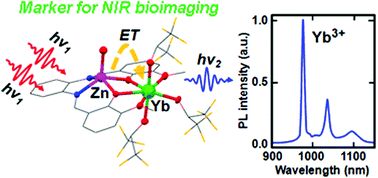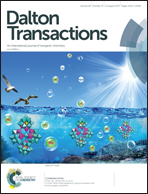Sensitization of NIR luminescence of Yb3+ by Zn2+ chromophores in heterometallic complexes with a bridging Schiff-base ligand†
Abstract
Herein, complexes [ZnL]2 (1), {(H2O)Zn(μ-L)Yb[OCH(CF3)2]3} (2), {[(CF3)2HCO]Zn(μ-L)Yb[OCH(CF3)2](μ-OH)}2 (3), and [(H2O)Ln2(L)3] (Ln = Yb (4) and Gd (5)) containing a bridging Schiff-base ligand (H2L = N,N′-bis(3-methoxy salicylidene)phenylene-1,2-diamine) were synthesized. The compounds 1–4 were structurally characterized. The ytterbium derivatives 2–4 exhibited bright NIR metal-centred photoluminescence (PL) of Yb3+ ion under one- (λex = 380 nm) and two-photon (λex = 750 nm) excitation. The superior luminescence properties of complex 2, which was suggested as a marker for NIR bioimaging, were explained via the strong absorption of the 375 nm LMCT state of the ZnL chromophore, efficient energy transfer from ZnL towards Yb3+ through a reversible ligand-to-lanthanide electron transfer process, and absence of luminescence quenchers (C–H and O–H groups) in the first coordination sphere of the rare-earth atom.



 Please wait while we load your content...
Please wait while we load your content...